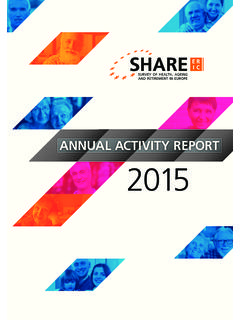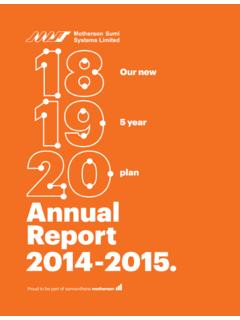Transcription of Annual Activity Report 2014
1 Annual Activity Report 2014 Austria /atBelgium /beCzech Republic /czDenmark /dkEstonia /eeFrance /frGermany /deGreece /grHungary /huIsrael /ilItaly /itNetherlands /nlPoland /plPortugal /ptSlovenia /siSpain /esSweden /seSwitzerland SHARE 2015 General Inquiries: Coordinator: Prof. Axel B rsch-Supan, Max Planck Institute for Social Law and Social Policy Munich Center for the Economics of Aging (MEA) Amalienstr. 33 80799 Munich GermanyLayout: Markus Berger, (SHARE Public Relations) 3 Contents 3 Foreword 5A. Scientific Aspects: Survey Work1. Overview of the Scientific Achievements 92. Wave 1-5 Data Dissemination and Data Usage 103. Economic and societal impact of the SHARE data 204. Wave 4 First Results Published in June 2013 225. Fieldwork Preparation of Wave 6 Starts in Early 2014 236. Questionnaire Innovations of Wave 6 (Pilot and Pretest) 267.
2 References and Further Reading 27B. Operational Aspects of the SHARE-ERIC1. SHARE-ERIC Council Meeting 292. Transfer from Tilburg to Munich 293. Accessions to SHARE-ERIC 29 4. Changes in the Scientific Partner Organizations 30C.
3 Financial Aspects1. Financial Statement for 2014 322. Funding Situation 33 Annex: Scientific Partners of the SHARE-ERIC 39 Annual Activity Report 20144 Note: This Annual Activity Report is written to give an overview about the SHARE activities as a whole in the relevant time frame, but also to fulfill the requirements of Article 17 par. 1 of COUNCIL REGULATION (EC) No 723/2009. Therefore it has to reflect first of all the situation of SHARE as European Research Infrastructure Consortium having several but not all countries from the SHARE Consortium as members. This may cause possibly irritations as there may be discrepancies between scientific activities, participation in a wave on the one hand and formal membership in the SHARE-ERIC on the other Council MeetingMunich, March 20155 ForewordIt is my pleasure to present to you the 3rd Annual Activity Report of SHARE-ERIC.
4 The purpose of this Report is to give an overview of all activities of SHARE in 2014 with particular regard to scientific, ope-rational and financial issues of are very pleased to announce that in 2014 two new members have acceded SHARE-ERIC: Sweden and Poland. Welcome to SHARE ERIC! With these two new members, SHARE-ERIC has now 11 full members and one SHARE consortium focused its scientific work in 2014 on the preparation of the fieldwork for the sixth survey wave which has started in January 2015. At the same time, the SHARE research community has produced a draft version of our fifth First Result Book . It makes extensive use of five waves of SHARE data with many new and surprising results. The final version of the fifth SHARE First Results Book will be presented in Brussels in the autumn of 2015. All this comes at the same time that SHARE has greatly improved the user friendliness of the SHARE database. The overlap between tasks aimed at wrapping up a wave and starting the next wave has been a key feature of SHARE.
5 It keeps the SHARE staff rather busy but ensures its scientific success. The graphical overview in Section shows this overlapping sequence of tasks with a picture of a typical schedule of a SHARE the EU Commission has given the green light to the change of the seat at the beginning of the year, the transfer of SHARE-ERIC from Tilburg, the Netherlands, to Munich, Germany, could be comple-ted in 2014 . This creates another opportunity to express our gratitude to our first host country, the Netherlands, as well as to the EU Commission for lending us support in the process of this year s Report , see section , we are particularly proud to present the economic and societal impact which SHARE has had by directly influencing policy decisions on both Member State and Union , let me also express that the transition from the last Framework Programme (FP7), which ended in 2014 , to the upcoming one (Horizon 2020), has posed new and serious challenges in financing SHARE.
6 To master these challenges, SHARE-ERIC has stimulated a debate on concepts of sustainable funding schemes for those research infrastructures which are only meaningful when sufficient European co-verage can be guaranteed. This debate needs to include all relevant stakeholders on the Member State and the Union level. We look forward to new positive developments and hope you enjoy reading this Angelika Willms-HergetChair of the SHARE-ERIC Council, March 20156 7 SHARE s Mission The Survey of Health, Ageing and Retirement in Europe seeks to analyse the process of population ageing in depth. It is the first study to examine the different ways in which people aged 50 and older live in 20 European countries from Sweden to Greece and Portugal to Estonia. Its scientific potential lies in the extensive data gathered from more than 100,000 individuals (approximately 220,000 interviews) all across Europe, covering the interplay bet-ween economic, health, and social factors in shaping older people s living A.
7 Scientific Aspects: Survey Work1. Overview of the Scientific Achievements 92. Wave 1-5 Data Dissemination and Data Usage 103. Economic and Societal Impact of the SHARE data 204. Wave 4 First Results Published in June 2013 225. Fieldwork Preparation of Wave 6 Starts in Early 2014 236. Questionnaire Innovations of Wave 6 (Pilot and Pretest) 267. References and Further Reading 279 Since late 2013, SHARE has issued a new simplified data set for training and teaching purposes, an enriched release update of its Job Episode Panel as well as a tool that enables users to calculate ap-propriate weights for statistical analyses of the data on their own. Furthermore, Germany is the first country where SHARE-linked administrative data is now available. This has contributed to a rise in the official user registration numbers of SHARE to about 4300 by the end of 2014 . A short overview is provided in Section 2.
8 The use of SHARE data has also strong political and as such socio-economic implications on both, the member states and the Union level. Details are described in Section 3. SHARE has started in 2014 to prepare a book on the first results of Wave 5, focusing on issues of social inclusion of the older population. A short preview is given in Section 4. SHARE has after starting with conceptual revisions already in 2013, finalized the preparation of Wave 6 during 2014 . Section 5 describes the progress during the Report period. At the end of 2014 , all major innovations of Wave 6 were completed with a survey instrument tested in multiple languages and able to provide after fieldwork the following new exciting data: bio-medical markers will be available through the collection of dried blood spots in 12 of the par-ticipating countries, new ISCO-harmonized job titles will be available for refined analyses including occupations, and cross-nationally harmonized, longitudinal social networks will allow for completely new analyses regarding the role change of social networks in all outcomes relevant for questions on ageing.
9 See Section 6 for Overview of the Scientific Achievements A. Scientific Aspects: Survey Work10 SHARE is a unique panel database of micro data on the health, socio-economic status and social and family networks of respondents aged 50 and older covering most of the European Union and Is-rael. SHARE is closely harmonized with several stu-dies worldwide, most closely with the HRS (USA), TILDA (Ireland) and ELSA (England). The network of harmonized global ageing studies also includes four Asian countries (China, Korea, Japan, and In-dia) and three Latin American countries (Mexico, Brazil and Argentina).To date, SHARE has collected four panel waves (2004, 2006, 2010, 2013) of current living circum-stances and one wave of retrospective life histories (2008, SHARELIFE); 5 additional waves are plan-ned until 2024. Since the release of Wave 4 data in November 2012 (see for details), SHARE provi-des data which has been generated by more than interviews in 19 countries to the scientific community free of charge.
10 In Wave 5, Luxembourg has joined as the 20th country. With the public release of Wave 5 data in March 2015, the data available to the scientific community will be based on more than interviews administered on about comprehensive overview of all available data is given in the SHARE data resource profile which has been authored by the central coordination team and published in 2013 open access by the International Journal of Epidemiology (B rsch-Supan et al. 2013a, available online via ).Figure 1 provides an update to this as it also incor-porates the Wave 5. It shows the sample sizes by country and wave. On average, the sample size in Wave 5 is about 4000 per country; the target size depending on funding is 6000 respondents. This number is motivated by three very different phases in the age range after 50 (50-65: pre-retirement; 65-80: healthy retirement; 80+: onset of illnesses) and a sample size of about 1000 for each gen-der.






